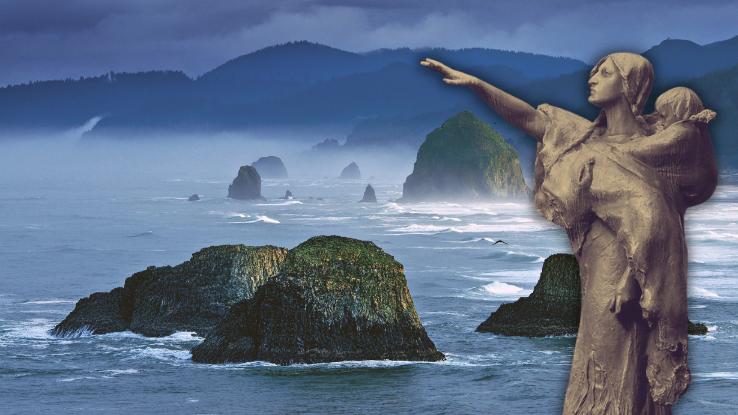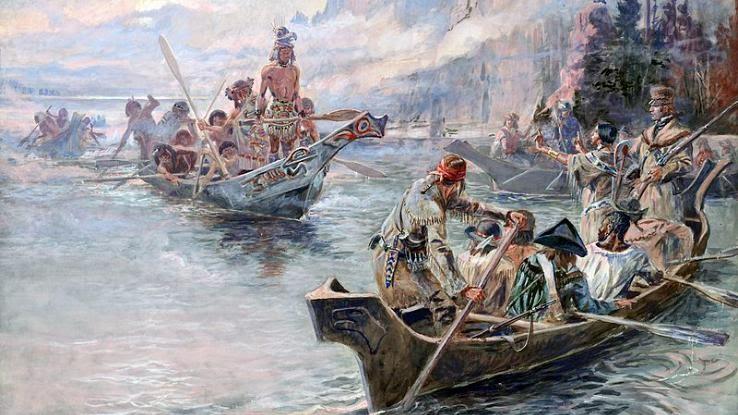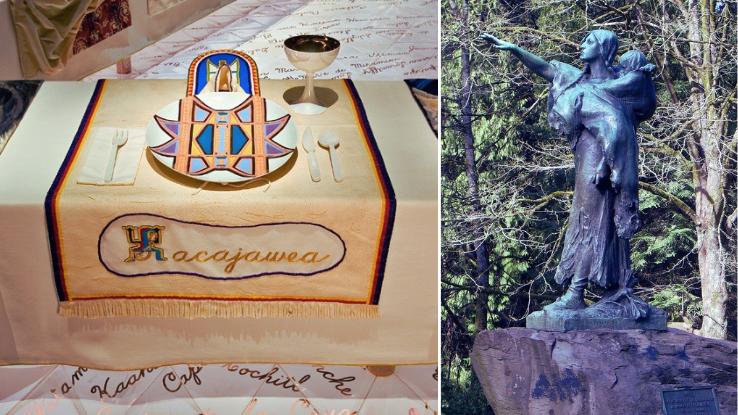Book Review for Slavery and Public History the Tough Stuff of American

If you learned of Sacagawea in your high-schoolhouse history form, it's probable that you think of her as a key part of the Lewis and Clark Expedition. Just the common delineation of Sacagawea is thoroughly distorted; many truths well-nigh her, and her circumstances, have either been twisted or left out entirely in club to conform a particular narrative. That is, the expedition was meant to exist a heroic, American try, and, as such, it'due south oftentimes romanticized by historians.
All the same, romanticizing the colonization of Ethnic peoples and lands is harmful — and using Sacagawea as a symbol of this alleged "heroic" mission is even more damaging. With this in heed, we're disclosing key aspects of Sacagawea's life in observance of Women's History Month.
Sacagewea's Early Years
Born around 1788 or 1789 into the Lemhi Shoshone ring of the Northern Shoshone, Sacagawea was part of the Agaidika people, or "Salmon-eater" Shoshone, and grew up in what is present-day Idaho. Although some accounts propose that her name is Hidatsa in origin, with "sacaga" pregnant "bird" and "wea" meaning "woman," many Shoshone people maintain that information technology'south a Shoshone name that means "gunkhole launcher" and is pronounced more like "Sacajawea" (via National Women'due south History Museum).

"Cagaagawia'sh, in Hidatsa, or Birdwoman, in English language, has become an important figure in both American Indian history and identity and as an icon of the women's suffrage motility," Alisha Deegan (Hidatsa/Sahnish), a citizen of the Mandan, Hidatsa, and Arikara Nation in Northward Dakota, and the interpretation and cultural resource program managing director at Pocketknife River Indian Villages National Celebrated Site, told Teen Vogue. Deegan goes on to notation that, "At that place are many questions about Cagaagawia'sh and her life, only what we practice know demonstrates that she was an amazing and strong woman."
Around 1800, when she was just 12 years onetime or so, Sacagawea and several other young Shoshone girls were kidnapped past Hidatsa warriors and, later on, enslaved. Over the next few years, Sacagawea became fluent in the Hidatsa language, a class of Siouan linguistic communication spoken in what is now considered present-twenty-four hour period North Dakota.
It'due south around this point in her story that details get a bit murkier. However, it is known that around 1803 or 1804, Sacagawea was sold as an enslaved person to, or "won" by, a French-Canadian fur trapper named Toussaint Charbonneau. Along with several other unknown Ethnic girls, Sacagawea was made to be one of Charbonneau's "wives." Although many history textbooks shy away from the truth, playwright and activist Carolyn Gage does not, writing that this was "a formalized child-rape arrangement brokered past adults," who also enslaved said child.
In 1803, President Thomas Jefferson purchased western territory that had been claimed by French colonizers. Known equally the Louisiana Buy, this act most doubled the size of the Usa. At that betoken, much of the middle of the continent had gone unexplored past white settlers. In order to map a safe road from the East Coast to the Pacific Body of water, Jefferson hired explorer Meriwether Lewis and frontiersman William Clark to atomic number 82 an expedition of roughly twoscore men upwards the Missouri.

While spending the winter months at an encampment near the Hidatsa-Mandan villages, Lewis and Clark met Charbonneau, who angled to join the expedition as an interpreter. The explorers allowed Charbonneau to bring together them, but information technology was clear that they saw Sacagawea, who was but 16 or 17 years old at the fourth dimension, as more of an asset to their colonialist trek than Charbonneau, who Lewis later chosen "a human of no peculiar merit" in his writings.
Not but was Sacagawea an interpreter herself, but she was also pregnant at the time, and it's clear that Lewis and Clark felt the optics of having an Indigenous mother with them — an expedition of mostly white men — was beneficial. That is, the Corps of Discovery probable idea that Indigenous people they encountered wouldn't recollect of them as a war party if Sacagawea was with them. While Sacagawea's abilities (and very presence) were deemed important by the Corps, information technology'due south important to note that she didn't have whatsoever bureau over joining or not joining the trek.
In addition to guiding the Corps of Discovery, Sacagawea was able to identify edible plants, communicate with other Indigenous people they encountered, and, in 1 case, ensured the survival of the expedition's documentation. That is, when a boat nearly capsized, Sacagawea collected all of the journals, navigational tools, and provisions that might accept otherwise been lost — all while conveying her baby, and Jean-Baptiste (nicknamed "Pompey"), on her back. Indebted to her efforts, Lewis and Clark named the Sacagawea River, which flows through present-twenty-four hours Montana, later her.
In July of 1805, the expedition reached the three forks of the Missouri River, which Sacagawea recognized. Virtually a month later, the Corps encountered Shoshone peoples and, in a twist of fate, Sacagawea realized that the chief, Cameahwait, was her brother. By that fall, the Corps reached the Pacific Ocean, cheers in large function to the horses the Shoshone people provided them.
Needing a identify to fix upwardly their winter encampment, the Corps again leaned on Sacagawea's knowledge. But determining where to install Fort Clatsop wasn't the concluding fourth dimension Sacagawea's insights proved invaluable. In fact, on the render journeying, it was Sacagawea who safely guided the group she was with through what's known today as the Bozeman Pass, an act that caused Clark to note that she had been "a pilot through this land."
Despite the instrumental role she played, Sacagawea was not given whatever compensation; the same was truthful for York, the enslaved Black homo who also made the roundtrip journeying with the Corps. Sacagawea's captor, on the other hand, was given $500 and over 300 acres of land, despite Lewis' dislike of him.
Sacagewea's Legacy Today
In that location isn't much in the mode of written documentation when it comes to Sacagawea's life after the expedition. It is well documented that Sacagawea's son was left in the intendance of Clark, who was (strangely) eager to oversee the boy's education in St. Louis. Afterwards that, Sacagawea seemingly went on fur-trading expeditions and gave birth to a daughter, Lisette, in 1812.

When it comes to her death, there'south quite a bit of uncertainty, too. While records from a fur-trading post note that she died of typhus in 1812, other accounts indicate that she didn't pass away at but 25 years quondam. The National Women'southward History Museum points to Indigenous oral histories, some of which suggest that "Sacagawea lived for many more than years in the Shoshone lands in Wyoming, until her death in 1884."
Cultura Colectiva points out that, "In 1925, Dr. Charles Eastman, an Indigenous doctor, was sent past the Agency of Indian Diplomacy to wait for the remains of the great Sacagawea." In retracing Sacagawea'southward steps, Dr. Eastman learned of a Shoshone woman, who went by the proper noun Porivo and lived on a Comanche reservation; Dr. Eastman believed this elder to exist Sacagawea.
"Though it is known that she separated from the calumniating Charbonneau, little else is sure about the remainder of Sacajawea's life," the Brooklyn Museum notes. "Most Native people believe she died in 1812 at Fort Mandan and is buried somewhere on the Standing Rock Sioux reservation lands, Due north Dakota, while some show states that she lived with the Shoshone tribe for many years after."
In fact, Sacagawea has two "official" burial sites. 1, in Corson County, South Dakota, aligns with the story that she died at just 25 years old. This site, located at Fort Manuel, was placed on the National Register of Historic Places in 1978 as the final resting place of Sacagawea, simply this completely discounts the oral history collected by both Dr. Eastman and Dr. Grace Hebard. The second site is located at Fort Washakie in the Wind River Reservation in Wyoming.
Co-ordinate to the National Park Service, in that location are more statues dedicated to Sacagawea than any other woman in American history. Unveiled in 1905, Alice Cooper's Sacagawea and Jean-Baptiste is i of the almost notable monuments. Often, the sculpture is credited with inspiring now-controversial author Eva Emery Dye, who, in writing, cemented the romanticization and colonialist depiction of Sacagawea.
Additionally, the National American Woman Suffrage Clan, mayhap not realizing the full story, saw Sacagawea as a symbol of women's independence. And, in 2000, the U.S. Mint aimed to accolade her with a golden dollar coin, but printing the likeness of someone who was enslaved past white men on currency is, to say the very least, a problematic choice.
But attempts to honor Sacagawea become beyond monuments, misguided coins and named natural landmarks. In fact, she is the only Ethnic woman represented in feminist artist Judy Chicago'due south installation The Dinner Political party, which features place settings for prominent, history-making women. "The circumstances surrounding her life take go the stuff of fable, prompting interpretation by historians, writers, and filmmakers," the Brooklyn Museum, which houses The Dinner Political party, notes. "In an era in which women, particularly Native American women, were considered either weak and helpless or dangerous, Sacajawea proved to be an icon of bravery."
In a letter entitled "To the Youth / OUR Futurity," Canadian Start Nations artist George Littlechild ponders Sacagawea's complicated, but of import, legacy. "It is a known fact that America glorifies historical figures such as Lewis and Clark, that they are commemorated for opening upward the Due west to 'Progress,' thus 'Civilizing' ancestral lands," he writes. "They take go cultural icons for their deeds…. In fact what did they truly practise for this land known as America?"
Venerated past some but rightly despised by others, Lewis, Clark and the whole trek were harbingers of the destruction, disease, and death that was still to come with the United States' westward expansion. "Information technology is up to the states to rewrite the history books," Littlechild writes, "to make modify and in a higher place all to have respect for all humanity…" And, in function, that tin can kickoff with looking beyond whitewashed history to understand historical figures like Sacagawea more honestly.
Source: https://www.reference.com/history/sacagawea-life-story?utm_content=params%3Ao%3D740005%26ad%3DdirN%26qo%3DserpIndex
0 Response to "Book Review for Slavery and Public History the Tough Stuff of American"
Postar um comentário